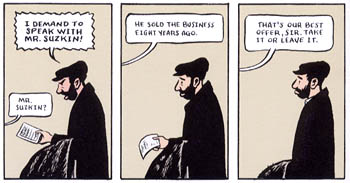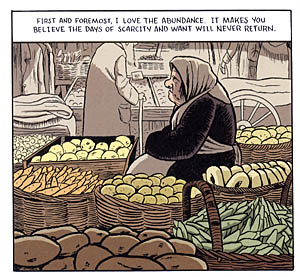 By James Sturm
By James Sturm
96 pages, color
Published by Drawn & Quarterly
One of the things I’ve always liked about James Sturm’s historical stories is that he is able to take events from the past and make them still pertinent to his present day readership. That’s never been more clear than with his latest book, Market Day, set in a European city near the turn of the 20th century, detailing the day in the life of a weaver taking his rugs to market for sale. What we get is not only a look into this man’s life, though, but a story that has to do with consumerism, the economy, and—most importantly—trying to create art rather than just product.
At first, Market Day seems like a fairly simple story. We watch Mendleman the rug-weaver head out with his rugs, cart, and horse on the long journey into town for market day, before the break of dawn. He frets over his wife Rachel who, eight months pregnant, is not accompanying him as is their normal routine. He thinks of worst-case scenarios for him and his family. He wonder how he would weave scenes that play out around him into a rug. And most importantly, he prepares to take his rugs to Albert Finkler’s store to sell them. And it’s there that Sturm lets Mendleman’s world fall apart, casting Mendleman into a spiral of despair and defeat.
 Mendleman’s experiences at A. Finkler & Son, the other market stores, and then at the emporium are hard to not compare to problems in present-day commerce. As small, family-owned and local businesses fold with the rising pressure of larger chains, Mendleman finding less places to sell his wares (and at much lower prices) is a scene that rings true. It’s a reminder that not only is this a problem that has existed longer than people might have thought, but that so much as one person going out of business effects numerous people. When Mendleman, exasperated, finally sells his rugs to the emporium, it’s hard to not feel horrible as it happens. Even as he bows to the pressure of receiving some money instead of none, you know that the greatly reduced wages are such that he and Rachel will hardly be able to make a living.
Mendleman’s experiences at A. Finkler & Son, the other market stores, and then at the emporium are hard to not compare to problems in present-day commerce. As small, family-owned and local businesses fold with the rising pressure of larger chains, Mendleman finding less places to sell his wares (and at much lower prices) is a scene that rings true. It’s a reminder that not only is this a problem that has existed longer than people might have thought, but that so much as one person going out of business effects numerous people. When Mendleman, exasperated, finally sells his rugs to the emporium, it’s hard to not feel horrible as it happens. Even as he bows to the pressure of receiving some money instead of none, you know that the greatly reduced wages are such that he and Rachel will hardly be able to make a living.
It’s also hard to ignore the other allegory in Market Day, as Mendleman talks about the care and precision he puts into his rugs to make them art, rather than to just dash them out as quickly as possible. It’s a struggle that many comic artists have no doubt had as well; you can whip things out quickly to get the needed cash, or strive for excellence and hope that someone will appreciate and value the hard work and care you’ve put into your art. Sturm is a comic creator who has worked for both the small press as well as the big comic companies, and it’s hard to not feel like Sturm is making his own feelings on his craft as a comic creator known here. As Mendleman’s one haven as a creator collapses and he considers giving up the art that he’s devoted his life to, it makes you think of the smaller publishing companies that have gone out of business in the last few years and which comic artists the art form has directly lost as a result.
 Even ignoring the various allegories and messages, Market Day is still a strong and moving book. It’s hard to not feel for Mendleman as he gets wrapped up in his worries and fear; we see that even when things are going well while he walks to the market with his merchandise at the start of the day, so after everything has gone wrong it’s multiplied a thousand fold. Sturm accentuates Mendleman’s mood with his expressive art, the deep, dark colors of the night surrounding him as he walks, the gloom just as apparent through the visuals as with the narration. Mendleman gradually transforms into little more than a black silhouette against the brown and gray surroundings, his despair covering him like a cloak.
Even ignoring the various allegories and messages, Market Day is still a strong and moving book. It’s hard to not feel for Mendleman as he gets wrapped up in his worries and fear; we see that even when things are going well while he walks to the market with his merchandise at the start of the day, so after everything has gone wrong it’s multiplied a thousand fold. Sturm accentuates Mendleman’s mood with his expressive art, the deep, dark colors of the night surrounding him as he walks, the gloom just as apparent through the visuals as with the narration. Mendleman gradually transforms into little more than a black silhouette against the brown and gray surroundings, his despair covering him like a cloak.
Fortunately, for every piece of gloom in the art there are other places that you can see brightness and beauty. I love the way that Sturm draws the market itself, with all of the various wares spread out; it makes you want to somehow visit this place yourself and shop. Even simple stores and stands look enticing, and there’s a wide plethora of people that Sturm draws for you to eye. The green countryside in particular serves as a visual contrast to the darker colors of the city, and it’s so bright and cheerful that it makes the later walk through its lanes and hills at night that much more gloomy.
Even if you read Market Day as little more than a day in the life of an eastern European man in the 1900s, it’s an engrossing read. As a commentary on art, and devotion to one’s craft, and to the shifting marketplace and how it can affect so many people with the smallest of changes, it’s that much more interesting. Market Day might not be a cheerful and heartwarming story about what it’s like to be an artist, but it’s certainly an important one for people hoping to survive in the 21st century market. This is a cautionary tale for not only those selling to the market, but those buying from the market as well. Highly recommended.
Purchase Links: Amazon.com | Powell’s Books
